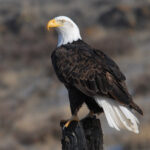Bald eagles have exceptional eyesight, which is significantly better than human eyesight. They have 20/4 or 20/5 vision, meaning they can see four or five times farther than the average person. However, bald eagles do not have excellent night vision due to the specific adaptations of their eyes.
Bald Eagles’ Daytime Vision
Bald eagles’ eyes are specially adapted for daytime hunting. They have a 340-degree field of view, compared to the human’s 180-degree field of view, and can use each eye individually or together due to their monocular and binocular vision. This allows them to spot prey the size of a rabbit three miles away.
Eagles have a higher density of photoreceptors, which allows them to perceive their whole view as zoomed in, all at once. They can also see a wider range of colors than humans, including ultraviolet light. This gives them an advantage in spotting prey and avoiding predators.
Bald Eagles’ Night Vision
 Image source: Pexels by Frank Cone
Image source: Pexels by Frank Cone
While bald eagles have exceptional daytime vision, their eyes are not as well-suited for low-light conditions. Their eyes have a high number of cones, which work well in bright light, but a low number of rods, which are responsible for low-light vision.
This means that while bald eagles can see very well during the day, their vision is significantly impaired at night. They do not have the same level of night vision as some other birds of prey, such as owls, which have a higher number of rods in their eyes.
Factors Affecting Bald Eagles’ Night Vision
There are several factors that contribute to the bald eagles’ limited night vision:
-
Eye Structure: Bald eagles’ eyes are large and fill most of their skull, which is an adaptation for their daytime hunting. However, this eye structure is not as well-suited for low-light conditions.
-
Photoreceptor Density: Bald eagles have a higher density of cones, which are responsible for color vision and detail in bright light, but a lower density of rods, which are responsible for low-light vision.
-
Pupil Size: Bald eagles’ pupils do not dilate as much as some other birds, which limits the amount of light that can enter their eyes at night.
-
Retinal Structure: The structure of the bald eagles’ retina is optimized for daytime vision, with a high concentration of cones and a lower concentration of rods.
Comparison to Other Birds of Prey
While bald eagles have exceptional daytime vision, they do not have the same level of night vision as some other birds of prey. For example, owls have a higher number of rods in their eyes, which allows them to see much better in low-light conditions.
Owls also have larger pupils that can dilate more, allowing more light to enter their eyes. Additionally, the structure of their retina is better suited for low-light vision, with a higher concentration of rods.
Conclusion
In summary, bald eagles have exceptional eyesight that is specifically adapted for daytime hunting. They can see much farther and with greater detail than humans, but they do not have excellent night vision. Their eyes are not as well-suited for low-light conditions, with a lower number of rods and a less adaptable pupil size. While bald eagles are impressive predators during the day, they are not as well-equipped for hunting at night as some other birds of prey.
References:
– What do we mean when we say that an eagle has “20/4” vision?
– The Best Eyes in the Animal Kingdom
– Nine Bald Eagle Facts That May Surprise You
– About the Bald Eagle



